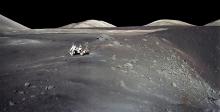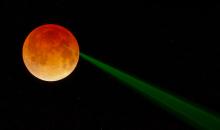Listen to today's episode of StarDate on the web the same day it airs in high-quality streaming audio without any extra ads or announcements. Choose a $8 one-month pass, or listen every day for a year for just $30.
You are here
Moon and Venus
Like the surface of Earth, the surface of the Moon sometimes shakes, rattles, and rolls. On the Moon, though, much of the rattling appears to be caused by the gravitational influence of Earth itself.
Apollo astronauts left seismometers on the Moon to measure any motions at the surface. They listened until late 1977, when they were shut down. During that time, they recorded about 1300 moonquakes. Most of them were pretty mild, although they could rattle on for hours.
Some of the quakes took place at the surface — the result of impacts by space rocks. But most of them were centered deep inside the Moon — hundreds of miles below the surface. And they occurred in cycles of about 27 days — about the same time it takes the Moon to orbit Earth.
A couple of studies in the last few years have blamed the quakes on the tides — the same effect that raises ocean tides here on Earth. Earth’s gravitational pull on the Moon is stronger than the Moon’s pull on Earth, creating tides in the solid lunar crust. That forms cracks deep inside the Moon. The sides of the cracks rub against each other, creating stress. Eventually, the stress releases with a jolt — creating a moonquake.
Look for the Moon just above the western horizon at sunset. It’s a beautiful thin crescent. And it has a beautiful companion: the planet Venus. It’s the brilliant “evening star,” to the left of the Moon.
More about the Moon in the evening sky tomorrow.
Script by Damond Benningfield






